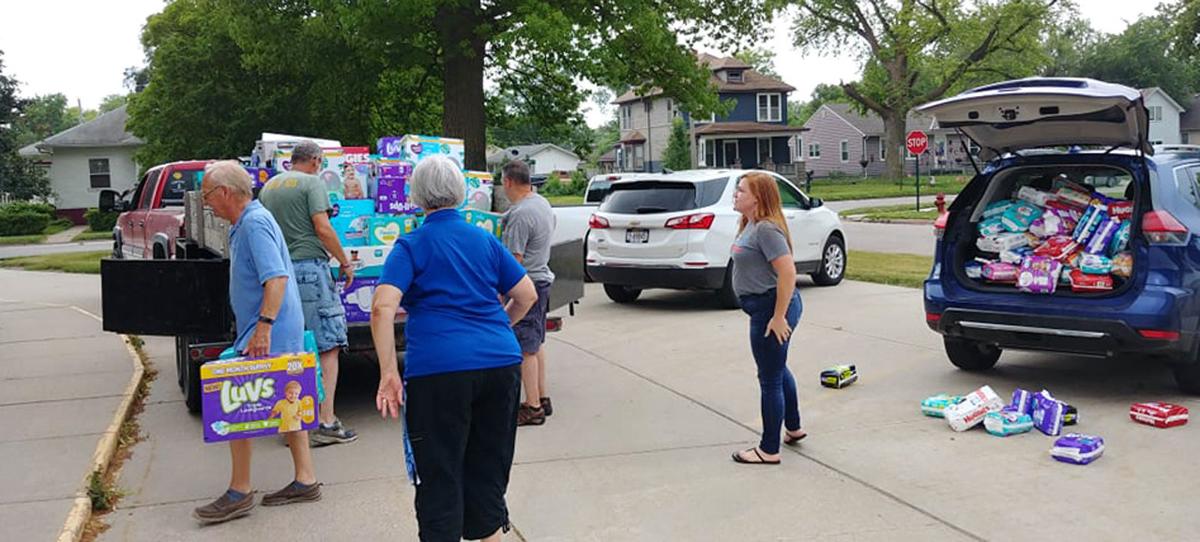
CEDAR RAPIDS — Despite days where organizers thought they might give out every diaper they had left on their shelves, the Eastern Iowa Diaper Bank has been able to meet a soaring demand for diapers throughout the COVID-19 pandemic and after the August derecho.
Eastern Iowa Health Center Chief Development Officer and diaper bank organizer Erin Langdon said 2020 was the diaper bank’s biggest year for the number of donors helping, with 1,338 people giving cash or diapers. It also saw the highest value per donation made.
“On those days when the shelves were getting low, the community stepped right back up the next day and donations started flowing in,” Langdon said.
The need for diapers is an often-overlooked measure of Americans’ economic reversals, said Joanne Samuel Goldblum, chief executive and founder of the National Diaper Bank Network. There are so many people “who do not have enough money to meet their basic needs, and what we’ve found is that diaper need is a window into poverty.”
In 2020, the National Diaper Bank Network distributed more than 100 million diapers to 220 diaper banks across the country, a 67 percent spike year-over-year.
The Eastern Iowa Diaper Bank, in southeast Cedar Rapids, is a member of the National Diaper Bank Network and received 100,000 diapers after the Aug. 10 derecho from Huggies, the founding sponsor of the national program.
In addition to the large donation, which Langdon said will supplement the supply through 2021, the diaper bank’s connection with the National Diaper Bank Network allowed it to buy diapers in bulk at a reduced price. That, along with an Amazon wishlist through which donors were able to buy goods for the bank, got the organization through supply slumps and a larger client base.
“One thing that was really evident, especially after the response from after the derecho, and then during this whole pandemic, it seemed like the community really embraced the collective responsibility for helping uplifting and empowering one another,” said Alejandro Pino, executive director of YPN and a diaper bank organizer.
The Eastern Iowa Diaper Bank opened its services broadly to the public in March 2020, temporarily moving away from a program that served participants only. Before the pandemic began in Iowa — and resuming once again in January — the diaper bank provides diapers to clients of the Eastern Iowa Health Center and YPN. In order to earn diapers throughout the year, families must complete well-check visits through the Health Center, finish a YPN program or participate in other services.
In 2020, the diaper bank distributed 647,205 diapers to an estimated 3,894 families. As 2020 came to a close it was giving out about 50,000 diapers a month.
Now, with normal programming back in place, Langdon said it’s distributing 15,000 to 18,000 diapers a month. There are about 2,000 families active in the program.
Pino said it would have been very difficult for the diaper bank to keep operating sustainably with such high demand, and it needs to continue serving families in the future.
The diaper bank distributed information starting in October on how to enroll in YPN and Eastern Iowa Health Center programs, and Langdon said the organizations have worked to make events and appointments as accessible as possible.
By offering diapers as incentives to go through programming, Pino said, the diaper bank is helping break barriers and the cycle of poverty.
“We look at that holistic approach to wellness,” Pino said.
Historically, most diaper bank clients live below the poverty line, a federal threshold capped at $26,500 a year for a family of four. One in 3 U.S. families could not afford diapers even before the coronavirus outbreak. But once the pandemic set in, and millions of Americans lost their jobs, the nation descended into a recession that disproportionately affected women and low-wage earners, leaving many to contend with eviction, debt and food insecurity.
The initial round of federal stimulus kept 17 million people out of poverty, but millions remain vulnerable while waiting for additional relief.
Most public aid programs don’t cover diapers, which run about $80 a month per child. No federal aid or welfare program covers diapers — not WIC, SNAP or cash assistance. States can distribute Temporary Assistance for Needy Families funds for that purpose, but that’s a fixed pot of money with restrictions.
A lack of assistance for families struggling to afford diapers is one of the main reasons the Eastern Iowa Diaper Bank was founded, Langdon said. When she joined the Eastern Iowa Health Center, the biggest need the 1,200 patients in prenatal care expressed was for diapers. Many parents are required to provide diapers to their children’s day care. This can force parents to ration diapers to be able to send their kids to day care while they go to work.
Republican U.S. Sen. Joni Ernst of Iowa has introduced a bill with Sen. Chris Murphy, D-Conn., to provide funds for diaper banks struggling to meet community needs. The COVID-19 Diaper Assistance Act would provide $200 million to the Social Services Block Grant program to go toward diaper assistance.
Pino said it’s great to see efforts in the government to try address this need, as it will at least raise awareness.
“People are starting to realize just how big diaper need is, not only within our community, but just nationally,” Pino said.
Comments: (319) 359-6330; brooklyn.draisey@southeastiowaunion.com
The Washington Post contributed.
The Link LonkMarch 14, 2021 at 06:38PM
https://ift.tt/3rM4cVH
Eastern Iowa Diaper Bank survives soaring demand from pandemic and derecho - The Gazette
https://ift.tt/2Comt7j
Diapers

No comments:
Post a Comment